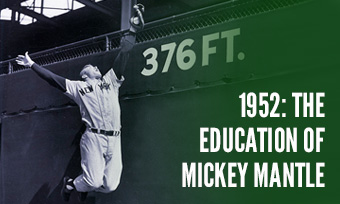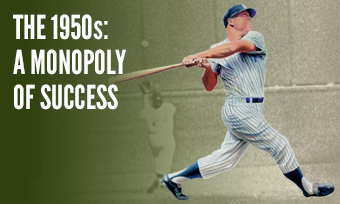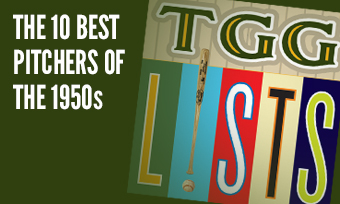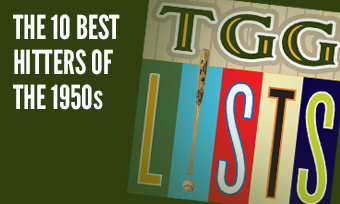The Yearly Reader
Leaders and Honors, 1952
Our list of baseball’s top 10 hitters and pitchers in both the American League and National League for the 1952 baseball season, as well as the awards and honors given to the game’s top achievers of the year.
The National League’s Top 10 Hitters, 1952
Bold type in brick red indicates league leader.
1. Stan Musial, St. Louis
Key Numbers: 154 games, .336 average, 105 runs, 194 hits, 42 doubles, 6 triples, 21 home runs, 91 RBIs, 96 walks, 27 intentional walks, .538 slugging percentage.
Musial justified the $35,000 raise he gave himself when handed a blank check by the Cardinals.
2. Hank Sauer, Chicago
Key Numbers: .270 average, 89 runs, 31 doubles, 37 home runs, 121 RBIs, 77 walks.
The 35-year-old slugger was the first modern MVP winner for a team that didn’t have a winning record; perhaps the voters gave it to him knowing that the Cubs’ 77-77 record would be their only non-losing campaign between 1946-63.
3. Jackie Robinson, Brooklyn
Key Numbers: .308 average, 104 runs, 19 home runs, 75 RBIs, 106 walks, 14 hit-by-pitches, 24 stolen bases, .440 on-base percentage.
Five years after his debut, did certain pitchers still have something against Robinson? His 14 times hit by pitches were a personal high. Jackie also set a Dodgers record by reaching base safely at least twice in each of his first 10 games. (Adrian Gonzalez will tie the mark in 2015.)
4. Gil Hodges, Brooklyn
Key Numbers: .254 average, 87 runs, 27 doubles, 32 home runs, 102 RBIs, 107 walks.
Despite a subpar average and a terrible April in which he didn’t knock in a single run, Hodges rebounded well and led the Dodgers in home runs, RBIs and walks (a career-high 107).
5. Ralph Kiner, Pittsburgh
Key Numbers: .244 average, 90 runs, 37 home runs, 87 RBIs, 110 walks.
For the seventh straight year, no National Leaguer hit more homers than Kiner, though he was tied during three of those years—including in 1952, with Hank Sauer.
6. Bobby Thomson, New York
Key Numbers: .270 average, 89 runs, 29 doubles, 14 triples, 24 home runs, 108 RBIs.
With Willie Mays (drafted) and Monte Irvin (injured) largely absent in the Giants’ lineup, Thomson did the best he could to make up.
7. Del Ennis, Philadelphia
Key Numbers: .303 average, 90 runs, 171 hits, 30 doubles, 10 triples, 20 home runs, 107 RBIs.
The Phillies’ prime power outlet re-energized after an off-1951, helping the Phillies get back into contention. (Robin Roberts had something to do with that as well.)
8. Duke Snider, Brooklyn
Key Numbers: .303 average, 80 runs, 25 doubles, 7 triples, 21 home runs, 92 RBIs.
The Duke of Flatbush ended a modestly potent campaign by muscling up for six homers and a .355 average in September—a hint of an impressive personal reign just around the corner.
9. Enos Slaughter, St. Louis
Key Numbers: .300 average, 17 doubles, 12 triples, 11 home runs, 101 RBIs, 70 walks.
With a youth movement soon to dawn in St. Louis, the 36-year-old Slaughter gave one last strong showing before eventually sliding into a part-time existence in the American League.
10. Solly Hemus, St. Louis
Key Numbers: .268 average, 105 runs, 28 doubles, 8 triples, 15 home runs, 52 RBIs, 96 walks, 20 hit-by-pitches.
The fiery infielder reveled with the arrival of pugnacious first-year Cardinals manager Eddie Stanky; his 20 times hit by a pitch were the most by a National Leaguer since 1910, and before Ron Hunt came along.
The American League’s Top 10 Hitters, 1952
1. Larry Doby, Cleveland
Key Numbers: .318 average, 109 runs, 169 hits, 28 doubles, 30 home runs, 126 RBIs, 144 walks, 9 intentional walks, .464 on-base percentage, .556 slugging percentage.
The AL’s first black player was now established as one of its best; he hit for the cycle for the only time in his career, and his home run on the season’s final day gave him first place over teammate (and fellow African-American) Luke Easter.
2. Al Rosen, Cleveland
Key Numbers: .302 average, 101 runs, 171 hits, 32 doubles, 5 triples, 28 home runs, 105 RBIs, 75 walks.
Rosen gave up golf, took up carrots and emulated Ted Williams’ swing in a successful quest to become one of the AL’s premier sluggers.
3. Mickey Mantle, New York
Key Numbers: .311 average, 94 runs, 171 hits, 37 doubles, 7 triples, 23 home runs, 87 RBIs, 75 walks, 111 strikeouts.
The only regrets regarding Mantle in 1952 were from all those kids who grew up wondering why they latched his pricey Topps baseball card to their bicycle wheel spokes to make funny noises.
4. Eddie Robinson, Chicago
Key Numbers: .296 average, 79 runs, 176 hits, 33 doubles, 22 home runs, 104 RBIs, 70 walks, 16 intentional walks, 12 hit-by-pitches.
The RBI machine topped off his career before being swapped in a postseason trade for AL batting champ Ferris Fain that did neither any good.
5. Yogi Berra, New York
Key Numbers: .273 average, 97 runs, 30 home runs, 98 RBIs.
In one of the years in which he didn’t win the AL MVP early in the 1950s, Berra set a career mark for home runs he would only equal later (in 1956).
6. Luke Easter, Cleveland
Key Numbers: 127 games, .263 average, 31 home runs, 97 RBIs.
A late arrival for both the majors and the Negro Leagues before it, the muscular 37-year-old slugger noted for hitting the longest-ever home run at Cleveland Stadium set a career high in taters during his third full year with the Indians.
7. Ferris Fain, Philadelphia
Key Numbers: .327 average, 82 runs, 176 hits, 43 doubles, 2 home runs, 59 RBIs, 105 walks, .438 on-base percentage.
Fain impressed by collecting his second straight AL batting crown, but visions of future titles never materialized after he was traded to the White Sox—where he quickly faded.
8. Vic Wertz, Detroit-St. Louis
Key Numbers: 122 games, .277 average, 23 home runs, 70 RBIs, 69 walks.
Hitting .346 after a midseason trade from a terrible Detroit team (50-104), Wertz was probably one of the few players to say he was relieved to be traded to the typically woebegone Browns.
9. Minnie Minoso, Chicago
Key Numbers: .281 average, 96 runs, 24 doubles, 9 triples, 13 home runs, 61 RBIs, 71 walks, 14 hit-by-pitches, 24 reached on error, 22 stolen bases, 16 caught stealing.
The Cuban native completed his evolution into becoming baseball’s ultimate disruptor, getting on base however he could—and then fighting for every extra 90 feet from there.
10. Bobby Avila, Cleveland
Key Numbers: .300 average, 102 runs, 179 hits, 26 doubles, 11 triples, 7 home runs, 45 RBIs, 12 stolen bases.
In his second full season, Avila became the first Mexican-born major leaguer to play in the All-Star Game.
The National League’s Top 10 Pitchers, 1952
1. Robin Roberts, Philadelphia
Key Numbers: 2.59 ERA, 28 wins, 7 losses, .800 win percentage, 39 appearances, 37 starts, 30 complete games, 330 innings, 45 walks.
The greatest of Roberts’ great years accounted for the most wins by a NL pitcher since Dizzy Dean’s 30 in 1934; his third of a remarkable 28 straight complete games, thrown in early September, lasted a remarkable 17 innings.
2. Joe Black, Brooklyn
Key Numbers: 2.15 ERA, 15 wins, 4 losses, 15 saves, 56 appearances, 2 starts, 142.1 innings.
The 1952 rookie experience would be as good as it got for Black; over five more major league seasons, he would produce an iffy 4.84 ERA.
3. Hoyt Wilhelm, New York
Key Numbers: 2.43 ERA, 15 wins, 3 losses, .833 win percentage, 71 appearances, 0 starts, 159.1 innings.
Wilhelm became the first rookie to lead the NL in both ERA and win percentage.
4. Warren Spahn, Boston
Key Numbers: 2.98 ERA, 14 wins, 19 losses, 40 appearances, 35 starts, 290 innings, 183 strikeouts.
Despite recording the same ERA as the season before while winning 22 games, Spahn set a personal low with 11 home losses—but with few people showing up to Braves Field a year before the team’s move to Milwaukee, the experience wasn’t so embarrassing. It was the only losing record he absorbed over his first 19 seasons.
5. Karl Drews, Philadelphia
Key Numbers: 2.72 ERA, 14 wins, 15 losses, 30 starts, 5 shutouts, 228.2 innings, 52 walks, 30 grounded into double plays.
Phillies hitters left their better bats at home when Drews pitched, supporting him with just 3.1 runs per start; hence the losing record.
6. Curt Simmons, Philadelphia
Key Numbers: 2.82 ERA, 14 wins, 8 losses, 28 starts, 6 shutouts, 201.1 innings.
The young southpaw returned from a military-forced hiatus of one year and change (he also missed the 1950 World Series) without skipping a beat.
7. Bob Rush, Chicago
Key Numbers: 2.70 ERA, 17 wins, 13 losses, 32 starts, 250.1 innings.
The typically frustrated Cubs starter could finally smile on a season where events went mostly his way—including a win at the All-Star Game, and the year’s longest consecutive scoreless inning streak (32.2).
8. Ken Raffensburger, Cincinnati
Key Numbers: 2.81 ERA, 17 wins, 13 losses, 38 appearances, 33 starts, 6 shutouts, 247 innings, 45 walks.
Exhibit One in the debate to keep players’ names off the backs of uniforms, Raffensberger got rare name recognition as a brief ace for the Reds.
9. Warren Hacker, Chicago
Key Numbers: 2.58 ERA, 15 wins, 9 losses, 33 appearances, 20 starts, 185 innings, 31 walks.
Mixing a fastball and knuckler, Hacker easily enjoyed his best year at the major league level; over the next four years, mediocrity would prevail as he posted a 32-60 record.
10. Sal Maglie, New York
Key Numbers: 2.92 ERA, 18 wins, 8 losses, .692 win percentage, 35 appearances, 31 starts, 216 innings.
No one was hotter to start the year than Maglie, who won each of his first nine starts with a scintillating 1.12 ERA.
The American League’s Top 10 Pitchers, 1952
1. Bob Lemon, Cleveland
Key Numbers: 2.50 ERA, 22 wins, 11 losses, 4 saves, 42 appearances, 36 starts, 28 complete games, 309.2 innings, 105 walks, 35 grounded into double plays.
After Lemon in 1952, no other American League pitcher threw over 300 innings for the entire 1950s.
2. Allie Reynolds, New York
Key Numbers: 2.06 ERA, 20 wins, 8 losses, .714 win percentage, 6 saves, 35 appearances, 29 starts, 24 complete games, 6 shutouts, 244.1 innings, 160 strikeouts.
Reynolds was as good a closer as he was a starter; he completed all but five of his starts, and earned saves in each of his six relief appearances—not allowing a single run over 9.1 innings.
3. Mike Garcia, Cleveland
Key Numbers: 2.37 ERA, 22 wins, 11 losses, 4 saves, 46 appearances, 36 starts, 6 shutouts, 292.1 innings.
After Bob Lemon (above) and Frank Lary in 1956, Garcia had the third-most innings thrown by an AL pitcher during the 1950s.
4. Bobby Shantz, Philadelphia
Key Numbers: 2.48 ERA, 24 wins, 7 losses, .774 win percentage, 33 starts, 27 complete games, 279.2 innings.
At 139 pounds, Shantz was certainly the majors’ lightest MVP but an 800-pound gorilla upon opposing hitters; ask Jackie Robinson and Stan Musial, two of the three NL stars Shantz faced—and struck out—at the All-Star Game.
5. Joe Dobson, Chicago
Key Numbers: 2.51 ERA, 14 wins, 10 losses, 25 starts, 200.2 innings.
The 35-year-old veteran, in his second year with the White Sox after a long tenure with the Red Sox, stifled foes one last time as he placed third among AL pitchers in on-base percentage allowed (.280).
6. Billy Pierce, Chicago
Key Numbers: 2.57 ERA, 15 wins, 12 losses, 32 starts, 255.1 innings.
A developing ace, Pierce found it difficult competing with the Big Boys—posting a 3-10 record yet still decent 3.35 ERA against the Yankees and Indians. Against the other five AL teams, he was 12-2 with a 1.88 figure.
7. Vic Raschi, New York
Key Numbers: 2.78 ERA, 16 wins, 6 losses, .727 win percentage, 31 starts, 223 innings.
Raschi was 13-2 at the start of August and was looking at the possibility of a fourth straight 20-win campaign before enduring a run of bad luck down the stretch.
8. Early Wynn, Cleveland
Key Numbers: 2.90 ERA, 23 wins, 12 losses, 3 saves, 42 appearances, 33 starts, 285.2 innings, 132 walks, 16 caught stealing, 24 grounded into double plays.
At some point, one had to wonder if Wynn should have had his name changed to “Win”; he paced the Indians in victories and helped make Cleveland field a trio of 20-game winners for the second straight year. Only three other AL teams—the 1920 Indians and White Sox, and the 1931 A’s—had done it once since the end of the Deadball Era.
9. Bob Porterfield, Washington
Key Numbers: 2.72 ERA, 13 wins, 14 losses, 29 starts, 231.1 innings.
Porterfield pitched well enough to secure a winning record, but he didn’t get enough hitting love from teammates to accomplish that simple task—even in the one year during the entire 1950s that the Senators finished above .500.
10. Ed Lopat, New York
Key Numbers: 2.53 ERA, 10 wins, 5 losses, 19 starts, 149.1 innings, 23 grounded into double plays.
To keep his fragile arm from falling apart, the Yankees had Lopat pitch every seven days; he responded by collecting a 5-0 record over his last six appearances.









